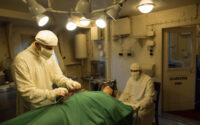Sanitary Inspector Questions Answers
The candidates can download the Sanitary Inspector Questions Answers for Health and Sanitary Inspector Exam. The Sanitary Inspector Questions Answers for Health and Sanitary Inspector Previous Papers will help the aspirants to crack the exam easily.
So Sanitary Inspector Questions Answers for Food and Sanitary Inspector is available. Aspirants can download Last Five years Sanitary Inspector Questions Answers for Health Sanitary. In addition to that, you can also get Sanitary Inspector Questions Answers for Health Sanitary Inspector.
The Sanitary Inspector Questions Answers Previous Papers are updated here. A vast number of applicants are browsing on the Internet for the Sanitary Inspector Questions Answers for Health and Sanitary Inspector Exam.
For those candidates, here we are providing the links for Sanitary Inspector Questions Answers for Health Sanitary Inspector.
Model Questions and Answers for Sanitary Inspector
1. What colour of Bio Medical waste is generated in a Hospital?
A. Yellow, Red, Blue, White
B. Yellow, Orange, Blue, White
C. Pink, Orange, White, Yellow
D. Pink, Orange, Blue, White
2. Contents of yellow colored waste
A. Plastic Waste
B. Glass Waste
C. Soiled Waste
D. None of the above
3. Contents of Red colored waste
A. Plastic Waste
B. Glass Waste
C. Soiled Waste
D. Metallic Sharp
4. Contents of Blue colored waste
A. Plastic Waste
B. Soiled Waste
C. Glass Waste
D. None of the above
5. Contents of White colored waste
A. Metallic Sharp
B. Glass Waste
C. Soiled Waste
D. Plastic waste
6. Which of the following is a correct statement?
A. Bio Medical waste need not to be segregated
B. Bio Medical waste needs to be segregated at the source of generation.
C. Bio Medical waste has to be mixed and then segregated later.
D. None of the above.
7. Disposal of Red colored waste.
A. Autoclaving and Auction to the registered recycler
B. Autoclaving, shredding and auction to the registered recycler
C. Incineration
D. None of the above
8. Disposal of Glass waste.
A. Autoclaving and auction to the registered recycler.
B. Autoclaving, shredding and auction to the registered recycler.
C. Auction to the register recycler.
D. All of the above.
9. Disposal of Metallic sharp.
A. Auction to the registered recycler.
B. Auction to the non-registered recycler.
C. Autoclaving and auction to the registered recycler.
D. None of the above.
10. Tick the correct statement.
A. No occupier shall establish onsite treatment and disposal facility if a service of common Bio Medical Waste facility is available at a distance of 75 Km.
B. No occupier shall establish onsite treatment and disposal facility if a service of common Bio Medical Waste facility is available at a distance of 100 Km.
C. No occupier shall establish onsite treatment and disposal facility if a service of common Bio Medical Waste facility is available at a distance of 50 Km.
D. None of the above.
11. All the health care workers involved in handling of Bio Medical Waste must be provided training on safe handling of Bio Medical Waste: –
A. At the time of induction and thereafter at least once every year.
B. At the time of induction and thereafter once in two years.
C. At the time of induction and thereafter once in five years.
D. None of the above.
12. _________ from the date of notification of these rules.
A. One year
B. Two years
C. Three years
D. Five years
13. What are the recommended vaccinations for health care workers handling Bio Medical Waste?
A. Hepatitis-B vaccine and Tetanus
B. Hepatitis-B vaccine and Hepatitis-C vaccine
C. Hepatitis-C vaccine and Tetanus
D. All of the above.
14. Establish a bar code system for bags or containing Bio Medical waste to be sent out of premises for any purpose within from date of notification of rules.
A. Two years.
B. Three Years.
C. One Year.
D. None of the above.
15. Maintain all records for operation of incineration, hydro or autoclaving etc. for a period of .
A. Five years.
B. Ten Years.
C. One year.
D. None of the above.
16. Which of the following is a correct statement?
A. Only Yellow colored polythene bags must be non-chlorinated.
B. Only yellow and red polythene bags must be non-chlorinated.
C. All polythene bags used for Bio Medical waste must be non-chlorinated.
D. None of the above.
17. All health care workers must be medically examined at the time of induction and as well as
A. Once in two year.
B. Once in five year.
C. Once in a year.
D. None of the above.
18. Cytotoxic Bio Medical waste must be disposed of in colored container
A. Red
B. Black
C. Yellow
D. Blue
19. Standards of autoclaving for bio medical waste.
A. A temperature not less than 121° C and pressure of 15 pounds (psi) for an autoclave residence time of not less than 60 minutes.
B. A temperature not less than 135° C and pressure of 31 pounds (psi) for an autoclave residence time of not less than 45 minutes.
C. C. A temperature not less than 149° C and pressure of 52 pounds (psi) for an autoclave residence time of not less than 30 minutes.
D. Any of these.
20. Vector mosquitoes for malaria is:-
A. Aedes
B. Culex
C. Anopheles
D. None of the above
21. Which is the most common vector of Rabies?
A. Dog
B. Cat
C. Monkey
D. None of the above.
22. What are the categories in segregation of municipal solid waste?
A. Wet waste
B. Dry waste
C. Both of them
D. None of the above
23. How is wet waste disposed?
A. Compositing
B. Incineration
C. Shredding
D. None of the above
24. What are the commonly used items for Personal Protective Equipment for waste management?
A. Heavy Duty Gloves
B. Face Mask
C. Chest Shield
D. All of the above
25. The disease which can be transmitted due to unsafe handling of Bio Medical Waste.
A. HIV
B. Hepatitis B
C. Tetanus
D. All of the above
26. What are the food and water borne diseases?
A. Cholera
B. Viral Hepatitis
C. Acute Gastro Enteritis
D. All of the above
27. What are the vector borne diseases?
A. Malaria, Filaria, Dengue & Chikungunya
B. Cardio vascular disease, RHD and Hypertension
C. Diabetes, Acute Renal Failure & Renal Kidney transplant
D. All of the above
28. Deficiency of Vitamin B is known as: –
A. Scurvy
B. BeriBeri
C. Rickets
D. Pellagra
29. Deficiency of Vitamin D is known as: –
A. BeriBeri
B. Rickets
C. Pellagra
D. Scurvy
30. The causative agent for smallpox is: –
A. Variola
B. Rubulavirus
C. CorynebacteriumDiphtheriae
D. Mycobacterium Tuberculosis
31. The causative agent for tuberculosis:
A. Mycobacterium Tuberculosis
B. Xeropthalmia Tuberculosis
C. Corynebacterium Tuberculosis
D. Variola Tuberculosis
32. The causative agent for Typhoid: –
A. SalmonellaTyphi
B. Vibrio Cholerae
C. Mycobacterium Tuberculosis
D. Tuberculosis
33. The incubation period of Hepatitis B is: –
A. 30 to 180 days
B. 01 to 30 clays
C. 30 to 60 days
D. 30 to 120 days
34. The incubation period of Cholera is: –
A. 05 to 12 days
B. 01 to 05 days
C. 01 to 12 days
D. 01 to 20 days
35. The incubation period of Diphtheria is: –
A. 05 to 12 days
B. 01 to 10 days
C. 01 to 15 days
D. 01 to 20 days
36. 7th April is celebrated as: –
A. World Leprosy Day
B. World Environment Day
C. World Polio Day
D. World Health Day
37. 24th October is celebrated as: –
A. World Health Day
B. World Polio Day
C. World Environment Day
D. World Yoga Day
38. 5th June is celebrated as: –
A. World Yoga Day
B. World Leprosy Day
C. World Polio Day
D. World Environment Day
39. 22nd April is celebrated as: –
A. World Leprosy Day
B. World Polio Day
C. World Yoga Day
D. World Earth Day
40. 4th February is celebrated as: –
A. World Polio Day
B. World Leprosy Day
C. World Health Day
D. World Canoer Day
41. Equipment used for calculating the Bleaching Powder requirement of water to make it potable is known as
A. Horrocks apparatus
B. Chloroscope
C. Fluoroscope
D. Endoscope
42. Dengue is caused by: –
A. Female Anopheles
B. Aedes Aegypti
C. Culex Mosquitoes
D. None of the above
43. Japanese Encephalitis is a vector borne disease:
A. Yes
B. No
C. Bacterial
D. Fungal
44. Poliomyelitis is transmitted by: –
A. Fecal-Oral Route
B. Contract with blood and bodily fluids
C. Breathing in an airborne virus
D. Being bitten by an insect
45. Influenza is transmitted by: –
A. By direct contact with infected individuals
B. By contact with contaminated objects
C. By inhalation of virus laden aerosols
D. All of the above
46. Scrub typhus is caused by: –
A. OrientiaTsutsugamushi
B. Variola Virus
C. Rubeola Virus
D. None of the above
47. Diabetes is a: –
A. Communicable Disease
B. Non-communicable Disease
C. Infectious
D. Painful
Download More Questions on Paramedical Science
- ECG Technician
- Dental Technician
- Emergency & Trauma Technician
- Medical Counsellor
- Dialysis Technician
- Nutritionist
- Physiotherapist
- Medical Record Technician
- Operation Theatre Technician
- Clinical Psychologist
- Ophthalmic Technician
- Radiographer Technician
- Ward Master
- Pharmacist
- Radiotherapy Technologist
- Clinical Instructor
- Medical Laboratory Technician
- X-Ray Technician



